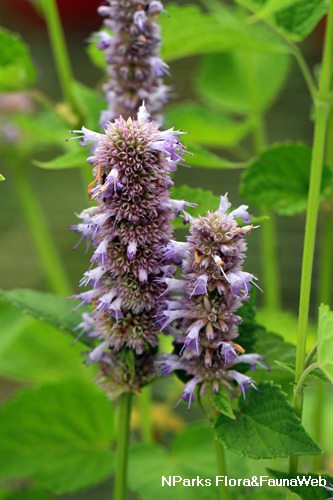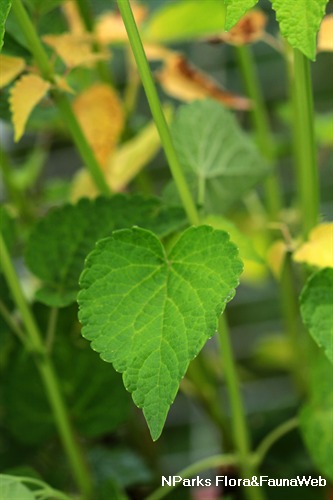
Back
Agastache foeniculum
| Family Name: | Lamiaceae (Labiatae) |
| Synonyms: | Agastache anethiodora |
| Common Name: | Blue Giant Hyssop, Anise Hyssop, 茴藿香 |
Name
Classifications and Characteristics
| Plant Division | Angiosperms (Flowering Seed Plants) |
|---|---|
| Plant Growth Form | Shrub |
Biogeography
| Native Habitat | Terrestrial |
|---|
Description and Ethnobotany
| Growth Form | A herbaceous plant growing to about 1 to 1.5 m tall and 30 to 61 cm wide. |
|---|---|
| Foliage | Leaves are oval shaped with coarsely toothed leaf margin. Leaves are green on the upper side and white on the underside with tiny flattened hairs. Leaf arrangement is opposite and foliage gives an anise or liquorice scent when crushed. |
| Stems | Stem is erect, 4-angled and mostly glabrous. |
| Flowers | Lavender to purple inflorescence is borne on terminal. Tiny lavender tubular flowers with hairy calyx are packed densely into cylindrical flower spikes about 8 to 16 cm long. |
| Fruit | Nutlets (2 mm long) are oblong and smooth with small brown hairs at the tip. |
| Similar | Agastache foeniculum is often confused with Agastache scrophulariaefolia (Purple Giant Hyssop) because of their similar flower colouration. However, they differ as A.scrophulariaefolia does not have anise-scented leaves and green underside. |
| Cultivation | Agastache foeniculum exhibit higher resistant to drought than other species in the same Mint family. |
| Ethnobotanical Uses | Edible Plant Parts : Edible Leaves, Edible Flowers, Edible Seeds Food (Fruit or Vegetable): Leaves, flowers and seeds are edible. The foliage has an anise fragrant and is used as flavouring in salads and teas. Flowers can be eaten raw while seeds are used in cakes. (Herb or Spice) Cut - Dried Flower: Flower spikes make attractive flower arrangement. |
Landscaping Features
| Desirable Plant Features | Ornamental Foliage, Fragrant (Flowers) |
|---|---|
| Landscape Uses | Small Gardens |
| Thematic Landscaping | Fragrant / Aromatherapy Garden, Butterfly Garden |
Fauna, Pollination and Dispersal
| Fauna Pollination Dispersal Associated Fauna | Bird-Attracting, Butterfly-Attracting |
|---|
Plant Care and Propagation
| Light Preference | Full Sun, Semi-Shade |
|---|---|
| Water Preference | Moderate Water |
| Rootzone Tolerance | Well-Drained Soils |
| Propagation Method | Seed |
Image Repository
Others
| Master ID | 32342 |
|---|---|
| Species ID | 6752 |
| Flora Disclaimer | The information in this website has been compiled from reliable sources, such as reference works on medicinal plants. It is not a substitute for medical advice or treatment and NParks does not purport to provide any medical advice. Readers should always consult his/her physician before using or consuming a plant for medicinal purposes. |



